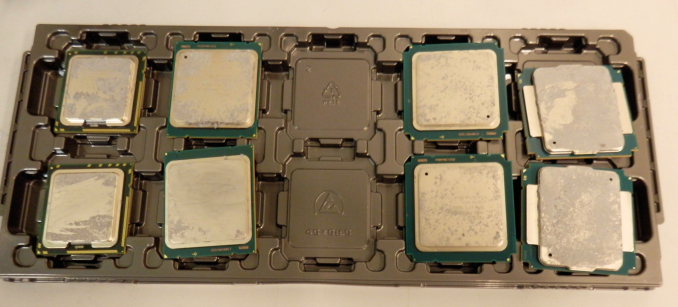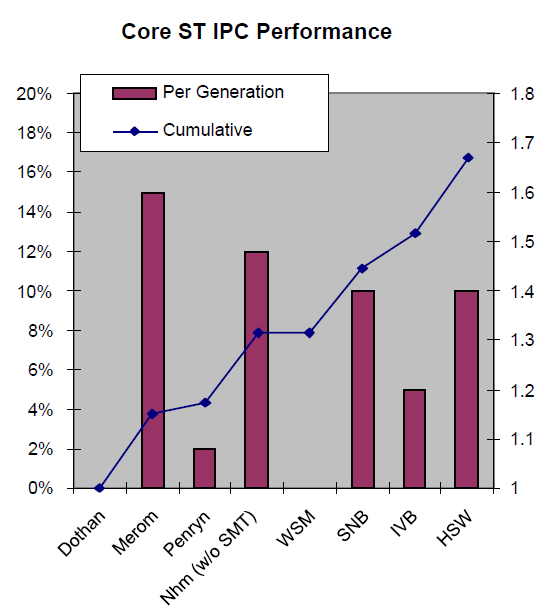Intel Xeon E5 Version 3: Up to 18 Haswell EP Cores
by Johan De Gelas on September 8, 2014 12:30 PM ESTUsing a Mobile Architecture Inside a 145W Server Chip
About 15 months after the appearance of the Haswell core in desktop products (June 2013), the "optimized-for-mobile" Haswell architecture is now being adopted into Intel server products.
Left to right: LGA1366 (Xeon 5600), LGA2011 (Xeon E5-2600v1/v2) and LGA2011v3 (E5-2600v3) socket.
Haswell is Intel's fourth tock, a new architecture on the same succesful 22nm process technology (the famous P1270 process) that was used for the Ivy Bridge EP or Xeon E5-2600 v2. Anand discussed the new Haswell architecture in great detail back in 2012, but as a refresher, let's quickly go over the improvements that the Haswell core brings.
Very little has changed in the front-end of the core compared to Ivy Bridge, with the exception of the usual branch prediction improvements and enlarged TLBs. As you might recall, it is the back-end, the execution part, that is largely improved in the Haswell architecture:
- Larger OoO Window (192 vs 168 entries)
- Deeper Load and Store buffers (72 vs 64, 42 vs 36)
- Larger scheduler (60 vs 54)
- The big splash: 8 instead of 6 execution ports: more execution resources for store address calculation, branches and integer processing.
All in all, Intel calculated that integer processing at the same clock speed should be about 10% better than on Ivy Bridge (Xeon E5-2600 v2, launched September 2013), 15-16% better than on Sandy Bridge (Xeon E5-2600, March 2012), and 27% than Nehalem (Xeon 5500, March 2009).
Even better performance improvements can be achieved by recompiling software and using the AVX2 SIMD instructions. The original AVX ISA extension was mostly about speeding up floating point intensive workloads, but AVX2 makes the SIMD integer instructions capable of working with 256-bit registers.
Unfortunately, in a virtualized environment, these ISA extensions are sometimes more curse than blessing. Running AVX/SSE (and other ISA extensions) code can disable the best virtualization features such as high availability, load balancing, and live migration (vMotion). Therefore, administrators will typically force CPUs to "keep quiet" about their newest ISA extensions (VMware EVC). So if you want to integrate a Haswell EP server inside an existing Sandy Bridge EP server cluster, all the new features including AVX2 that were not present in the Sandy Bridge EP are not available. The results is that in virtualized clusters, ISA extensions are rarely used.
Instead, AVX2 code will typically run on a "native" OS. The best known use of AVX2 code is inside video encoders. However, the technology might still prove to be more useful to enterprises that don't work with pixels but with business data. Intel has demonstrated that the AVX2 instructions can also be used for accelerating the compression of data inside in-memory databases (SAP HANA, Microsoft Hekaton), so the integer flavor of AVX2 might become important for fast and massive data mining applications.
Last but not least, the new bit field manipulation and the use of 256-bit registers can speed up quite a few cryptographic algorithms. Large websites will probably be the application inside the datacenter that benefits quickly from AVX2. Simply using the right libraries might speed up RSA-2048 (opening a secure connection), SHA-256 (hashing), and AES-GCM. We will discuss this in more detail in our performance review.
Floating point
Floating point code should benefit too, as Intel has finally included Fused Multiply Add (FMA) instructions. Peak FLOP performance is doubled once again. This should benefit a whole range of HPC applications, which also tend to be recompiled much quicker than the traditional server applications. The L1 and L2 cache bandwidth has also been doubled to better cope with the needs of AVX2 instructions.












85 Comments
View All Comments
cmikeh2 - Monday, September 8, 2014 - link
In the SKU comparison table you have the E5-2690V2 listed as a 12/24 part when it is in fact a 10/20 part. Just a tiny quibble. Overall a fantastic read.KAlmquist - Monday, September 8, 2014 - link
Also, the 2637 v2 is 4/8, not 6/12.isa - Monday, September 8, 2014 - link
Looking forward to a new supercomputer record using these behemoths.Bruce Allen - Monday, September 8, 2014 - link
Awesome article. I'd love to see Cinebench and other applications tests. We do a lot of rendering (currently with older dual Xeons) and would love to compare these new Xeons versus the new 5960X chips - software license costs per computer are so high that the 5960X setups will need much higher price/performance to be worth it. We actually use Cinema 4D in production so those scores are relevant. We use V-Ray, Mental Ray and Arnold for Maya too but in general those track with the Cinebench scores so they are a decent guide. Thank you!Ian Cutress - Monday, September 8, 2014 - link
I've got some E5 v3 Xeons in for a more workstation oriented review. Look out for that soon :)fastgeek - Monday, September 8, 2014 - link
From my notes a while back... two E5-2690 v3's (all cores + turbo enabled) under 2012 Server yielded 3,129 for multithreaded and 79 for single.While not Haswell, I can tell you that four E5-4657L V2's returned 4,722 / 94 respectively.
Hope that helps somewhat. :-)
fastgeek - Monday, September 8, 2014 - link
I don't see a way to edit my previous comment; but those scores were from Cinebench R15wireframed - Saturday, September 20, 2014 - link
You pay for licenses for render Nodes? Switch to 3DS, and you get 9999 nodes for free (unless they changed the licensing since I last checked). :)Lone Ranger - Monday, September 8, 2014 - link
You make mention that the large core count chips are pretty good about raising their clock rate when only a few cores are active. Under Linux, what is the best way to see actual turbo frequencies? cpuinfo doesn't show live/actual clock rate.JohanAnandtech - Monday, September 8, 2014 - link
The best way to do this is using Intel's PCM. However, this does not work right now (only on Sandy and Ivy, not Haswel) . I deduced it from the fact that performance was almost identical and previous profiling of some of our benchmarks.